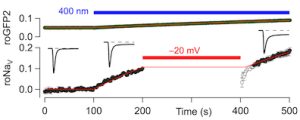roNaV: A nonphotonic gateable ROS sensor
Response of roGFP2 (top) and the ratiometric roNaV signal (bottom) to blue light. At -50 mV roNaV is inactivated and, thus, protected from ROS attack.
Illustration: FSU BiophysikThe current study presents a ratiometric sensor of intracellular reactive species (RS) levels based on genetically engineered voltage-gated sodium channels (roNaV). roNaV can be used for detecting oxidative modification that occurs near the plasma membrane with a sensitivity similar to existing fluorescence-based sensors. roNaV does not need excitation light for sensing, and thus, can be used to detect phototoxic cellular modifications. The RS dynamic range of roNaV is easily manipulated by means of the endogenous channel inactivation mechanism. Moreover, roNaV was used to assess RS lifetime in individual mammalian cells.
